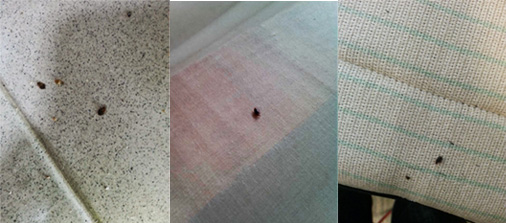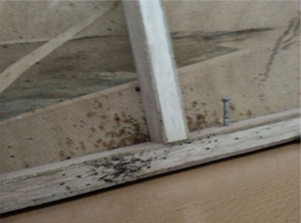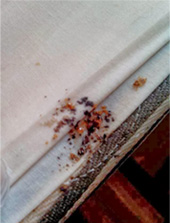
Bed-bugs are parasitic insects of the cimicid family that feed exclusively on blood. Adults grow to
4mm long.
Bed-bugs and eggs can be easily brought in from other infested dwellings on a visiting person's
clothing or luggage or Infested items (such as furniture, clothing, or backpacks)

Bed-bugs frass is like some black spot and it always can
be found near the bed

Bed-bugs frass is like some
black spot and it always can be
found near the bed.
Introduction
This bug probably received its common name of bed bug from its close association with human sleeping beds where it often seek refuge during daylight, only to come out to feed on the bed’s occupants at night. The bed bug is an ectoparasite of primarily humans but will also attack poultry and other mammals and birds. It is found throughout the world.
Adult about 4-5 mm long; broadly oval and flat, color brown to reddish brown (after feeding). Female bed bugs lay 1-5 eggs per day with 1 mm long, white eggs being deposited individually in cracks or on rough surface and secured with a transparent cement for an average total of 200 eggs. There are 5 nymphal instars with a blood meal required for each molt. About 3-10 minutes are required for each blood meal, during which saliva containing an anticoagulant is injected. Although the bite of bed bugs is painless, around 80% of people develop an allergic reaction to the saliva injected by the bug as it feed. Without a blood meal, once-fed nymphs can survive an average of 51 days; Adult can survive for up to 6-7 months if they are well fed.
Typically bed bugs can be found around mattress buttons and beading, in box springs or their coverings, and in any crevice of a wooden bed frame, such as where members join. Other places to check are wall hangings such as picture frames, night stands, door and window frames, conduits, etc. Bed bugs can be introduced into a structure via used furniture or luggage, it have been also found in transportation vehicles such as boats, train, airplanes, and buses as well as in the seats of movie theatre.
Control
A thorough inspection is indispensable. Treat any bed bugs found with an appropriately labeled pesticide, areas include mattresses, bed frames, wall crevices, and baseboards. Great care should be taken when treating mattresses, box springs, and upholstery to keep pesticide exposure to a minimum; allow for thorough drying before reuse. Infant’s and infirmed person’s bedding and bed frames should not be treated. They should be replaced with uninfested items.




